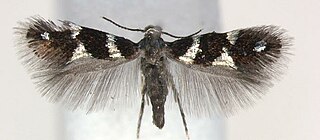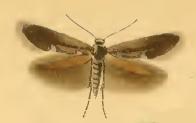
The Heliozelidae, commonly known as shield-bearer moths, are a family of small, day flying monotrysian moths distributed worldwide. The larvae of most heliozelid species are leaf miners who cut distinctive shield-shaped cases from the surface of the host leaf, hence the common name. Some species are considered pests of commercial crops such as grapevines, cranberries, and walnuts. The taxonomy of this family is poorly understood.

Heliozela resplendella is a moth of the Heliozelidae family. It is found from Fennoscandia and northern Russia to the Pyrenees, Alps and Romania and from Ireland to the Baltic region.
Antispila ampelopsia is a moth of the family Heliozelidae. It was described by Kuroko in 1961. It is found in Japan.
Antispila orbiculella is a moth of the family Heliozelidae. It was described by Kuroko in 1961. It is found in Japan.
Antispila corniella is a moth of the family Heliozelidae. It was described by Kuroko in 1961. It is found in Japan (Kyushu).
Antispila iviella is a moth of the family Heliozelidae. It was described by Kuroko in 1961. It is found in Japan (Yakushima).
Antispila hikosana is a moth of the family Heliozelidae. It was described by Kuroko in 1961. It is found in Japan (Kyushu).
Antispila hydrangifoliella is a moth of the family Heliozelidae. It was described by Kuroko in 1961. It is found in Japan (Kyushu).
Antispila purplella is a moth of the family Heliozelidae. It was described by Kuroko in 1961. It is found in Japan (Kyushu).
Antispila distyliella is a moth of the family Heliozelidae. It is found on the Ryukyu Islands in Japan.

Heliozela is genus of moths of the family Heliozelidae, described by Gottlieb August Wilhelm Herrich-Schäffer in 1853.
Heliozela ahenea is a moth of the Heliozelidae family. It was described by Walsingham in 1897, and is found in the West Indies.
Heliozela angulata is a moth of the family Heliozelidae. It was described by Lee, Hirowatari and Kuroko in 2006 and is endemic to Japan (Honshu).
Heliozela brevitalea is a moth of the family Heliozelidae. It was described by Lee, Hirowatari and Kuroko in 2006 and is endemic to Japan (Honshu).
Heliozela glabrata is a moth of the family Heliozelidae. It was described by Lee, Hirowatari and Kuroko in 2006. It is found in Japan (Honshu).
Heliozela limbata is a moth of the family Heliozelidae. It was described by Lee, Hirowatari and Kuroko in 2006 and is endemic to Japan.
Elachista nipponicella is a moth of the family Elachistidae that is found in Japan.
Epermenia ijimai is a moth of the family Epermeniidae. It is endemic to Hokkaido, Japan.
Bucculatrix univoca is a moth in the family Bucculatricidae. It was described by Edward Meyrick in 1918. It is found in Japan, Taiwan and India.

